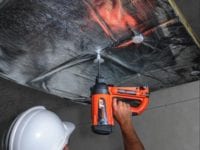How NOT To Install Insulation To Concrete, Block, Steel Studs, or Wood
Up until now, fastening any type of insulation was something to avoid at all costs. For years we have sold stick pins with washers and glue, and witnessed foreman begrudgingly accept the dull task ahead. Look closely at the picture below.

Imagine dipping the flat plate in a bucket of glue, pushing it against the wall, and waiting for it to dry. In the meantime, this sharp nail is pointing out from the wall towards people and eyeballs passing by. Hours later, when the glue has dried, you can finally push your insulation through the stick pins. One more step: Now you must go back and stick a plate washer over the point of the nail so the insulation will not fall away from the wall. Obviously, this is a ridiculous amount of labor and also very dangerous and messy.
Some people have used a strip load powder tool with a long pin and a washer, but this has it’s own drawbacks. Powder actuated tools (such as the Cobra or XT-540) are very hard to control, in terms of power. Especially with long pins they likely will not drive the pin in all the way. They will also drive it in too far, damaging the insulation, and the thermal rating it provides. They also require a license to operate.
A Simple Solution

Meet the “Insulfast” tool by Ramset. Ramset has solved all of the problems listed above with a battery and fuel cell powered tool. This tool offers a simple, one-step approach to the entire process. You simply place the insulation in the desired spot, put a Insulfast washer pin on the nose of the tool, and pull the trigger. The insulation is instantly attached with the perfect amount of power, without damaging the material. This system has been found to be up to 4 times faster than other methods.
Another benefit to this tool is the fastener selection. Ramset has simplified this process by dividing the fasteners into 2 categories: concrete/block and steel/wood. Once you make this distinction you simply select the fastener length that matches the thickness of you insulation. For example, if you are attaching 2″ rigid insulation to concrete, you would choose the IFC-200 pin. The pin is slightly longer than 2″ so it will penetrate the concrete with just enough depth to hold. Additionally, it doesn’t matter the type of insulation you are using, the Insulfast will work with it all. This includes: mineral wool, extruded polystyrene, expanded polystyrene, fiberglass, or Polyisocyanurate. That covers just about everything!
Selection Chart:

Thermal Efficiency
One last factor to consider is thermal efficiency. Insulation is being specced more and more often in new construction projects in an effort to save energy. The Insulfast system has the highest thermal efficiency rating of all options at 99.5%. Additionally, it maintains this rating all the way up to 6″ thick insulation applications. Other options drop down in efficiency dramatically as the thickness increases. There is not an engineer out there that does not value this rating. I’ve included a chart below to illustrate this:

Conclusion
Over the past 2 years, since the tool’s release, we have given a dozen customers this tool as an alternative. Every single customer has been convinced and happy with the results. Most of them have used this system multiple times. It has taken their hesitation away from bidding on projects with rigid insulation on the exterior of multi-story buildings. They know they can install the product without the risk of increased labor, or damaging pieces of expensive material. Ramset has developed a fastening system that we feel will be the industry standard over the next couple years. There simply no comparison on the market to this fastening system.

